#greensboro four
Explore tagged Tumblr posts
Photo



#OnThisDay in 1960, the F. W. Woolworth lunch counter in Greensboro, North Carolina, was desegregated.
Six months earlier, four North Carolina A&T State University students known as the #GreensboroFour “sat-in” at the whites–only lunch counter of retail store. When they were refused service, they sat peacefully until the store closed.
Their actions that day sparked a sit-in movement that eventually spread to 55 cities in 13 states, desegregating lunch counters one-by-one across the nation.
64 years later, we honor the #GreensboroFour’s bravery, and share this history as a reminder that young people have POWER. 🙌🏿
169 notes
·
View notes
Text
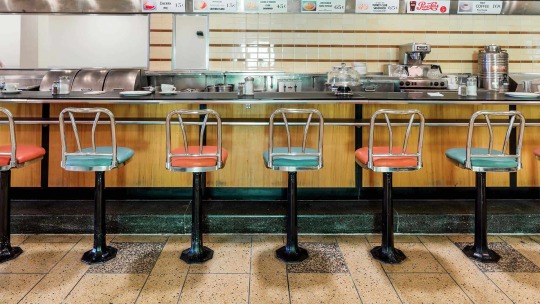
F. W. Woolworth's Building; International Civil Rights Center & Museum
Surfing around I saw this photo out of the corner of my eye. I knew exactly where it was taken and its significance. I was kinda shocked.
The photo link is to a page at The Civil Rights Trail, The Civil Rights Center and Museum are in Greensboro. There's a short video of Robert Petterson talking about the lunch counter sit-ins in 1960. Four freshmen students at North Carolina Agricultural and Technical State University--Aggies--led the demostrations: and became known at the Greensboro Four : David Richmond, Franklin McCain, Ezell A. Blair, Jr., and Joseph McNeil.
I was pretty little in 1960, I am not even sure we had a televison set at home. That those stools at Woolworth"s are so iconic to me shows how powerful the movement of sit-ins were. Certainly I'm old enough to remember racist segregation. The thousands of young people who participated in sit-ins inspired me as a lad. I knew they were creating something good. At least trying to make living better for all of us.
19 notes
·
View notes
Text

Standing tall at North Carolina A&T State University, the February One Monument honors the Greensboro Four and their courageous stand for civil rights. This powerful symbol of change reminds us of the enduring impact of their bravery and determination. Read more about their legacy in my blog post: https://americatbe.wordpress.com/2024/10/03/honoring-courage-the-february-one-monument-in-north-carolina/
#february one#civil rights#greensboro four#legacy#equality#a&t four#sit in#woolworths sit in#civil rights movement#history matters#black excellence#activism#social justice#north carolina#historic monument#inspiration
3 notes
·
View notes
Text
Black History Month -- The Greensboro Four
Today is February 4th … and I have been remiss. You see, February is Black History Month in both the U.S. and in Canada, and I usually start the month with a post on that topic, but I let time slip away from me this year. Ah well, I shall try to make up for it … and luckily, we get an extra day in February this year, so that should help! Black History is every bit as much a part of American…
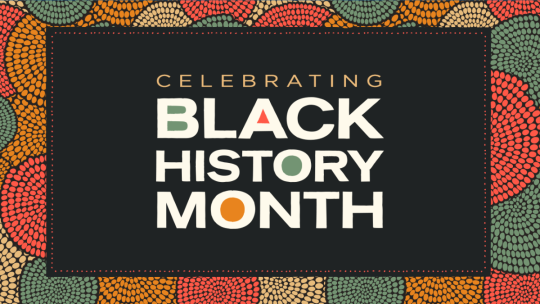
View On WordPress
#David Richmond#Franklin McCain#Greensboro Four#Jibreel Khazan#Joseph McNeil#sit-in protests#Woolworth lunch counter
0 notes
Text

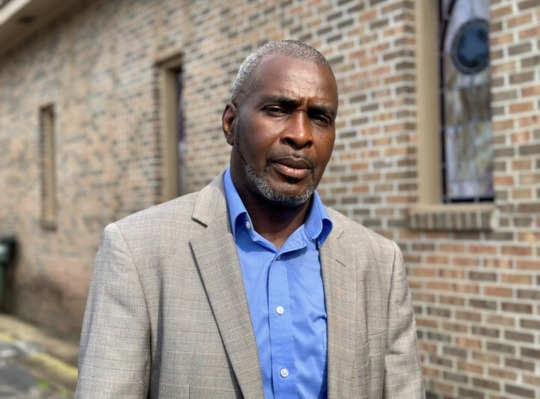
Patrick Braxton became the first Black mayor of Newbern, Alabama, when he was elected in 2020, but since then he has fought with the previous administration to actually serve in office. (Aallyah Wright/Capital B)
NEWBERN, Ala. — There’s a power struggle in Newbern, Alabama, and the rural town’s first Black mayor is at war with the previous administration who he says locked him out of Town Hall.
After years of racist harassment and intimidation, Patrick Braxton is fed up, and in a federal civil rights lawsuit he is accusing town officials of conspiring to deny his civil rights and his position because of his race.
“When I first became mayor, [a white woman told me] the town was not ready for a Black mayor,” Braxton recalls.
The town is 85% Black, and 29% of Black people here live below the poverty line.
“What did she mean by the town wasn’t ready for a Black mayor? They, meaning white people?” Capital B asked.
“Yes. No change,” Braxton says.
Decades removed from a seemingly Jim Crow South, white people continue to thwart Black political progress by refusing to allow them to govern themselves or participate in the country’s democracy, several residents told Capital B. While litigation may take months or years to resolve, Braxton and community members are working to organize voter education, registration, and transportation ahead of the 2024 general election.
But the tension has been brewing for years.
Two years ago, Braxton says he was the only volunteer firefighter in his department to respond to a tree fire near a Black person’s home in the town of 275 people. As Braxton, 57, actively worked to put out the fire, he says, one of his white colleagues tried to take the keys to his fire truck to keep him from using it.
In another incident, Braxton, who was off duty at the time, overheard an emergency dispatch call for a Black woman experiencing a heart attack. He drove to the fire station to retrieve the automated external defibrillator, or AED machine, but the locks were changed, so he couldn’t get into the facility. He raced back to his house, grabbed his personal machine, and drove over to the house, but he didn’t make it in time to save her. Braxton wasn’t able to gain access to the building or equipment until the Hale County Emergency Management Agency director intervened, the lawsuit said.
“I have been on several house fires by myself,” Braxton says. “They hear the radio and wouldn’t come. I know they hear it because I called dispatch, and dispatch set the tone call three or four times for Newbern because we got a certain tone.”
This has become the new norm for Braxton ever since he became the first Black mayor of his hometown in 2020. For the past three years, he’s been fighting to serve and hold on to the title of mayor, first reported by Lee Hedgepeth, a freelance journalist based in Alabama.
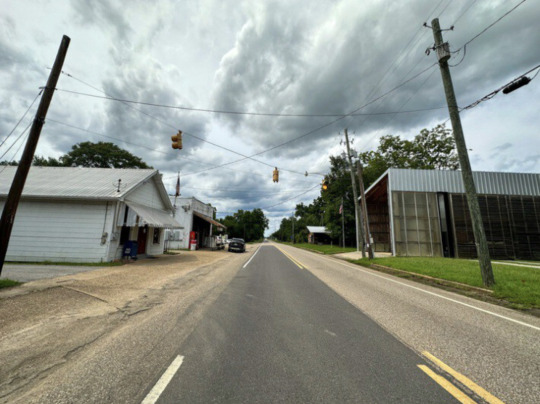
Incorporated in 1854, Newbern, Alabama, today has a population of 275 people — 85% of whom are Black. (Aallyah Wright/Capital B)
Not only has he been locked out of the town hall and fought fires alone, but he’s been followed by a drone and unable to retrieve the town’s mail and financial accounts, he says. Rather than concede, Haywood “Woody” Stokes III, the former white mayor, along with his council members, reappointed themselves to their positions after ordering a special election that no one knew about.
Braxton is suing them, the People’s Bank of Greensboro, and the postmaster at the U.S. Post Office.
For at least 60 years, there’s never been an election in the town. Instead, the mantle has been treated as a “hand me down” by the small percentage of white residents, according to several residents Capital B interviewed. After being the only one to submit qualifying paperwork and statement of economic interests, Braxton became the mayor.
(continue reading)
#politics#white supremacy#patrick braxton#woody stokes#republicans#alabama#sundown towns#racism#voter suppression
3K notes
·
View notes
Photo




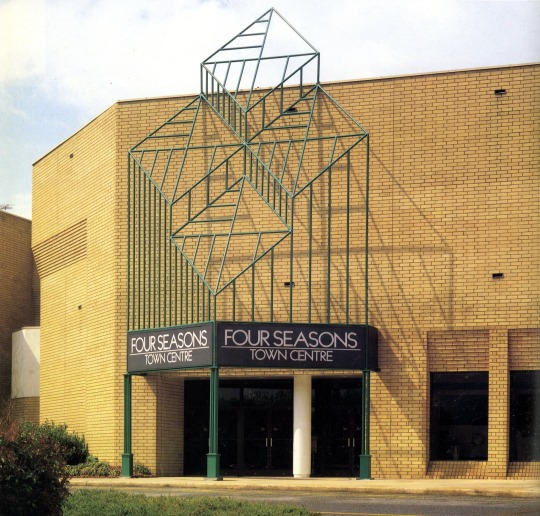



Four Seasons Town Centre - Greensboro, NC (Opened April 1987)
Designed by International Design Group, Inc of NYC, and RS & H of North Carolina.
Scanned from the book, ‘Shopping Centers and Malls 2′ (1988) and the Dec. 1987 issue of Contract Interiors Magazine.
2K notes
·
View notes
Text

NEWBERN, Ala. — There’s a power struggle in Newbern, Alabama, and the rural town’s first Black mayor is at war with the previous administration who he says locked him out of Town Hall.
After years of racist harassment and intimidation, Patrick Braxton is fed up, and in a federal civil rights lawsuit he is accusing town officials of conspiring to deny his civil rights and his position because of his race.
“When I first became mayor, [a white woman told me] the town was not ready for a Black mayor,” Braxton recalls.
The town is 85% Black, and 29% of Black people here live below the poverty line.
“What did she mean by the town wasn’t ready for a Black mayor? They, meaning white people?” Capital B asked.
“Yes. No change,” Braxton says.
Decades removed from a seemingly Jim Crow South, white people continue to thwart Black political progress by refusing to allow them to govern themselves or participate in the country’s democracy, several residents told Capital B. While litigation may take months or years to resolve, Braxton and community members are working to organize voter education, registration, and transportation ahead of the 2024 general election.
But the tension has been brewing for years.
Two years ago, Braxton says he was the only volunteer firefighter in his department to respond to a tree fire near a Black person’s home in the town of 275 people. As Braxton, 57, actively worked to put out the fire, he says, one of his white colleagues tried to take the keys to his fire truck to keep him from using it.
In another incident, Braxton, who was off duty at the time, overheard an emergency dispatch call for a Black woman experiencing a heart attack. He drove to the fire station to retrieve the automated external defibrillator, or AED machine, but the locks were changed, so he couldn’t get into the facility. He raced back to his house, grabbed his personal machine, and drove over to the house, but he didn’t make it in time to save her. Braxton wasn’t able to gain access to the building or equipment until the Hale County Emergency Management Agency director intervened, the lawsuit said.
“I have been on several house fires by myself,” Braxton says. “They hear the radio and wouldn’t come. I know they hear it because I called dispatch, and dispatch set the tone call three or four times for Newbern because we got a certain tone.”

Not only has he been locked out of the town hall and fought fires alone, but he’s been followed by a drone and unable to retrieve the town’s mail and financial accounts, he says. Rather than concede, Haywood “Woody” Stokes III, the former white mayor, along with his council members, reappointed themselves to their positions after ordering a special election that no one knew about.
Braxton is suing them, the People’s Bank of Greensboro, and the postmaster at the U.S. Post Office.
For at least 60 years, there’s never been an election in the town. Instead, the mantle has been treated as a “hand me down” by the small percentage of white residents, according to several residents Capital B interviewed. After being the only one to submit qualifying paperwork and statement of economic interests, Braxton became the mayor.
Stokes and his council — which consists of three white people (Gary Broussard, Jesse Leverett, Willie Tucker) and one Black person (Voncille Brown Thomas) — deny any wrongdoing in their response to the amended complaint filed on April 17. They also claim qualified immunity, which protects state and local officials from individual liability from civil lawsuits.
The attorneys for all parties, including the previous town council, the bank, and Lynn Thiebe, the postmaster at the post office, did not respond to requests for comment.
The town where voting never was
Over the past 50 years, Newbern has held a majority Black population. The town was incorporated in 1854 and became known as a farm town. The Great Depression and the mechanization of the cotton industry contributed to Newbern’s economic and population decline, according to the Encyclopedia of Alabama.

Today, across Newbern’s 1.2 square miles sits the town hall and volunteer fire department constructed by Auburn’s students, an aging library, U.S. Post Office, and Mercantile, the only store there, which Black people seldom frequent because of high prices and a lack of variety of products, Braxton says.
“They want to know why Black [people] don’t shop with them. You don’t have nothin’ the Black [people] want or need,” he says. “No gasoline. … They used to sell country-time bacon and cheese and souse meat. They stopped selling that because they say they didn’t like how it feel on their hands when they cuttin’ the meat.”
To help unify the town, Braxton began hosting annual Halloween parties for the children, and game day for the senior citizens. But his efforts haven’t been enough to stop some people from moving for better jobs, industry, and quality of life.
Residents say the white town leaders have done little to help the predominantly Black area thrive over the years. They question how the town has spent its finances, as Black residents continue to struggle. Under the American Rescue Plan Act, Newbern received $30,000, according to an estimated funding sheet by Alabama Democratic U.S. Rep. Terri Sewell, but residents say they can’t see where it has gone.
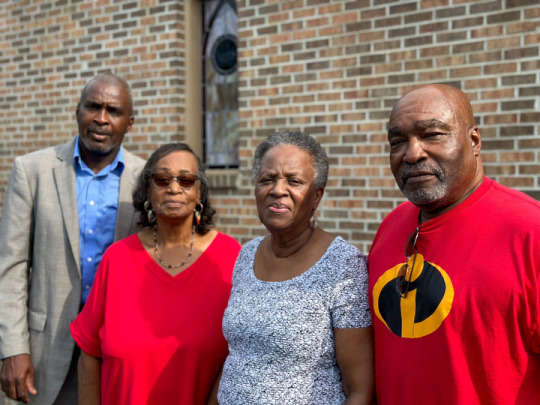
At the First Baptist Church of Newbern, Braxton, three of his selected council members — Janice Quarles, 72, Barbara Patrick, 78, and James Ballard, 76 — and the Rev. James Williams, 77, could only remember two former mayors: Robert Walthall, who served as mayor for 44 years, and Paul Owens, who served on the council for 33 years and mayor for 11.
“At one point, we didn’t even know who the mayor was,” Ballard recalls. “If you knew somebody and you was white, and your grandfather was in office when he died or got sick, he passed it on down to the grandson or son, and it’s been that way throughout the history of Newbern.”
Quarles agreed, adding: “It took me a while to know that Mr. Owens was the mayor. I just thought he was just a little man cleaning up on the side of the road, sometimes picking up paper. I didn’t know until I was told that ‘Well, he’s the mayor now.’”
Braxton mentioned he heard of a Black man named Mr. Hicks who previously sought office years ago.
“This was before my time, but I heard Mr. Hicks had won the mayor seat and they took it from him the next day [or] the next night,” Braxton said. “It was another Black guy, had won years ago, and they took it from.”
“I hadn’t heard that one,” Ballard chimes in, sitting a few seats away from Braxton.
“How does someone take the seat from him, if he won?” Capital B asked.
“The same way they’re trying to do now with Mayor Braxton,” Quarles chuckled. “Maybe at that time — I know if it was Mr. Hicks — he really had nobody else to stand up with him.”
Despite the rumor, what they did know for sure: There was never an election, and Stokes had been in office since 2008.
The costs to challenging the white power structure
After years of disinvestment, Braxton’s frustrations mounted at the height of the COVID-19 pandemic, when he says Stokes refused to commemorate state holidays or hang up American flags. When the COVID-19 pandemic hit, the majority-white council failed to provide supplies such as disinfectant, masks, and humidifiers to residents to mitigate the risks of contracting the virus.
Instead of waiting, Braxton made several trips to neighboring Greensboro, about 10 miles away, to get food and other items to distribute to Black and white residents. He also placed signs around town about vaccination. He later found his signs had been destroyed and put in “a burn pile,” he said.
After years of unmet needs of the community, Braxton decided to qualify for mayor. Only one Black person — Brown Thomas, who served with Stokes —has ever been named to the council. After Braxton told Stokes, the acting mayor, his intention to run, the conspiracy began, the lawsuit states.
According to the lawsuit, Stokes gave Braxton the wrong information on how to qualify for mayor. Braxton then consulted with the Alabama Conference of Black Mayors, and the organization told him to file his statement of candidacy and statement of the economic interests with the circuit clerk of Hale County and online with the state, the lawsuit states. Vickie Moore, the organization’s executive director, said it also guided Braxton on how to prepare for his first meeting and other mayoral duties.
Moore, an Alabama native and former mayor of Slocomb, said she has never heard of other cases across the state where elected officials who have never been elected are able to serve. This case with Braxton is “racism,” she said.
“The true value of a person can’t be judged by the color of their skin, and that’s what’s happening in this case here, and it’s the worst racism I’ve ever seen,” Moore said. “We have fought so hard for simple rights. It’s one of the most discouraging but encouraging things because it encourages us to continue to move forward … and continue to fight.”
Political and legal experts say what’s happening in Newbern is rare, but the tactics to suppress Black power aren’t, especially across the South. From tampering with ballot boxes to restricting reading material, “the South has been resistant to all types of changes” said Emmitt Riley III, associate professor of political science and Africana Studies at The University of the South.
“This is a clear case of white [people] attempting to seize and maintain political power in the face of someone who went through the appropriate steps to qualify and to run for office and by default wins because no one else qualified,” Riley added. “This raises a number of questions about democracy and a free and fair system of governance.”
Riley mentioned a different, but similar case in rural Greenwood, Mississippi. Sheriel Perkins, a longtime City Council member, became the first Black female mayor in 2006, serving for only two years. She ran again in 2013 and lost by 206 votes to incumbent Carolyn McAdams, who is white. Perkins contested the results, alleging voter fraud. White people allegedly paid other white people to live in the city in order to participate in the election and cast a legal vote, Riley said. In that case, the state Supreme Court dismissed the case and “found Perkins presented no evidence” that anyone voted illegally in a precinct, but rather it was the election materials that ended up in the wrong precincts.
“It was also on record that one white woman got on the witness stand and said, ‘I came back to vote because I was contacted to vote by X person.’ I think you see these tactics happening all across the South in local elections, in particular,” Riley said. “It becomes really difficult for people to really litigate these cases because in many cases it goes before the state courts, and state courts have not been really welcoming to overturning elections and ordering new elections.”
Another example: Camilla, Georgia.
In 2015, Rufus Davis was elected as the first Black male mayor of rural, predominantly Black Camilla. In 2017, the six-person City Council — half Black and half white — voted to deny him a set of keys to City Hall, which includes his office. Davis claimed the white city manager, Bennett Adams, had been keeping him from carrying out his mayoral duties.
The next year, Davis, along with Black City Council member Venterra Pollard, boycotted the city’s meetings because of “discrimination within the city government,” he told a local news outlet. Some of the claims included the absence of Black officers in the police department, and the city’s segregated cemetery, where Black people cannot be buried next to white people. (The wire fence that divided the cemetery was taken down in 2018). In 2018, some citizens of the small town of about 5,000 people wanted to remove Davis from office and circulated a petition that garnered about 200 signatures. In 2019, he did not seek re-election for office.
“You’re not the mayor”
After being the only person to qualify and submit proper paperwork for any municipal office, Braxton became mayor-elect and the first Black mayor in Newbern’s history on July 22, 2020.
Following the announcement, Braxton appointed members to join his council, consistent with the practice of previous leadership. He asked both white and Black people to serve, he said, but the white people told him they didn’t want to get involved.
The next month, Stokes and the former council members, Broussard, Leverett, Brown Thomas, and Tucker, called a secret meeting to adopt an ordinance to conduct a special election on Oct. 6 because they “allegedly forgot to qualify as candidates,” according to the lawsuit, which also alleges the meeting was not publicized. The defendants deny this claim, but admit to filing statements of candidacy to be elected at the special election, according to their response to an amended complaint filed on their behalf.
Because Stokes and his council were the only ones to qualify for the Oct. 6 election, they reappointed themselves as the town council. On Nov. 2, 2020, Braxton and his council members were sworn into office and filed an oath of office with the county probate judge’s office. Ten days later, the city attorney’s office executed an oath of office for Stokes and his council.
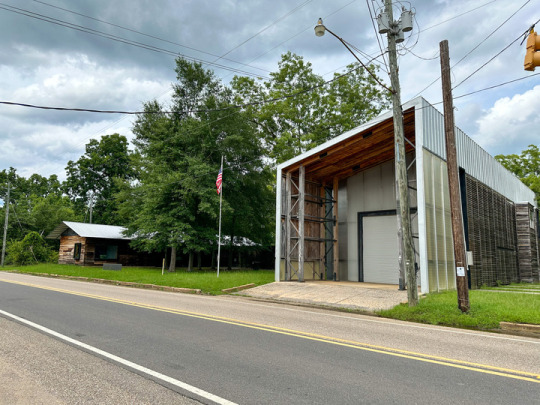
After Braxton held his first town meeting in November, Stokes changed the locks to Town Hall to keep him and his council from accessing the building. For months, the two went back and forth on changing the locks until Braxton could no longer gain access. At some point, Braxton says he discovered all official town records had been removed or destroyed, except for a few boxes containing meeting minutes and other documents.
Braxton also was prevented from accessing the town’s financial records with the People’s Bank of Greensboro and the city clerk, and obtaining mail from the town’s post office. At every turn, he was met with a familiar answer: “You’re not the mayor.” Separately, he’s had drones following him to his home and mother’s home and had a white guy almost run him off the road, he says.
Braxton asserts he’s experienced these levels of harassment and intimidation to keep him from being the mayor, he said.
“Not having the Lord on your side, you woulda’ gave up,” he told Capital B.
‘Ready to fire away’
In the midst of the obstacles, Braxton kept pushing. He partnered with LaQuenna Lewis, founder of Love Is What Love Does, a Selma-based nonprofit focused on enriching the lives of disadvantaged people in Dallas, Perry, and Hale counties through such means as food distribution, youth programming, and help with utility bills. While meeting with Braxton, Lewis learned more about his case and became an investigator with her friend Leslie Sebastian, a former advocacy attorney based in California.
The three began reviewing thousands of documents from the few boxes Braxton found in Town Hall, reaching out to several lawyers and state lawmakers such as Sen. Bobby Singleton and organizations such as the Southern Poverty Law Center. No one wanted to help.
When the white residents learned Lewis was helping Braxton, she, too, began receiving threats early last year. She received handwritten notes in the mail with swastikas and derogatory names such as the n-word and b-word. One of theletters had a drawing of her and Braxton being lynched.
Another letter said they had been watching her at the food distribution site and hoped she and Braxton died. They also made reference to her children, she said. Lewis provided photos of the letters, but Capital B will not publish them. In October, Lewis and her children found their house burned to the ground. The cause was undetermined, but she thinks it may have been connected.
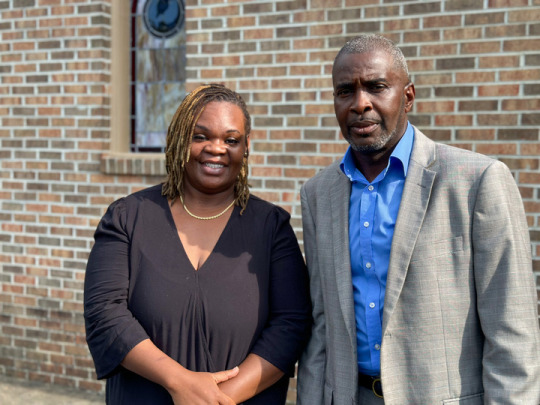
Lewis, Sebastian, and Braxton continued to look for attorneys that would take the case. Braxton filed a complaint in Alabama’s circuit court last November, but his attorney at the time stopped answering his calls. In January, they found a new attorney, Richard Rouco, who filed an amended complaint in federal court.
“He went through a total of five attorneys prior to me meeting them last year, and they pretty much took his money. We ran into some big law firms who were supposed to help and they kind of misled him,” Lewis says.
Right now, the lawsuit is in the early stages, Rouco says, and the two central issues of the case center on whether the previous council with Stokes were elected as they claim and if they gave proper notice.
Braxton and his team say they are committed to still doing the work in light of the lawsuit. Despite the obstacles, Braxton is running for mayor again in 2025. Through AlabamaLove.org, the group is raising money to provide voter education and registration, and address food security and youth programming. Additionally, they all hope they can finally bring their vision of a new Newbern to life.
For Braxton, it’s bringing grocery and convenience stores to the town. Quarles wants an educational and recreational center for children. Williams, the First Baptist Church minister, wants to build partnerships to secure grants in hopes of getting internet and more stores.
“I believe we done put a spark to the rocket, and it’s going [to get ready] to fire away,” Williams says at his church. “This rocket ready to fire away, and it’s been hovering too long.”
Correction: In Newbern, Alabama, 29% of the Black population lives below the poverty line. An earlier version of this story misstated the percentage
#alabama#Newbern Alabama#A Black Man Was Elected Mayor in Rural Alabama#but the White Town Leaders Won’t Let Him Serve#Patrick Braxton#AlabamaLove.org#black lives matter
372 notes
·
View notes
Photo
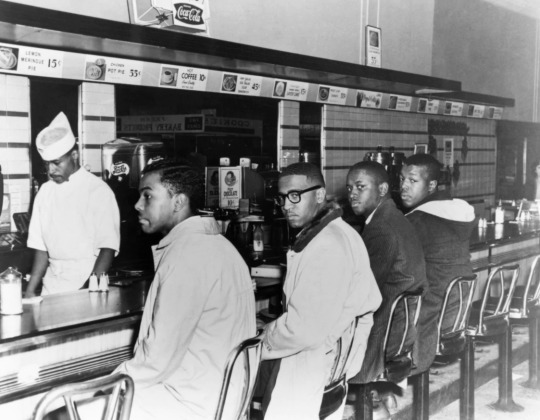
Today in the US, Black history month begins, on the anniversary of civil rights sit-ins beginning in Greensboro, North Carolina in 1960 when four Black college students refused to move from a Woolworth lunch counter when they were denied service. While many sit-ins had taken place in years prior, none had previously sparked a mass direct action movement against Jim Crow segregation laws. On this day, 1 February 1960, Joseph McNeil, Jibreel Khazan, David Richmond and Franklin McCainand began their protest, and refused to leave Woolworth's when directed to by management. A police officer soon arrived, but didn't appear to know what to do other than look vaguely threatening. Eventually the manager decided to close the store, and then the men went home. McCain later told Christopher Wilson, a journalist with Smithsonian magazine, “Almost instantaneously, after sitting down on a simple, dumb stool, I felt so relieved. I felt so clean, and I felt as though I had gained a little bit of my manhood by that simple act”. The protesters then continued organising, importantly including young Black women at Bennett College, and came back the following day with up to 16 more people. Within a few days there were hundreds, including some white students from the Women's College of the University of North Carolina. The movement then spread around the country. By the following September over 70,000 people had participated in sit ins against segregation. The Greensboro Woolworth's desegregated on July 25, 1960, and overt segregation was eventually banned in 1964. * In our new Stories web app, you can browse all of the stories in our archive about Black history and see sources and links to more information, as well as map locations where available: https://stories.workingclasshistory.com/tag/7662/black-history https://www.facebook.com/workingclasshistory/photos/a.296224173896073/2199822513536220/?type=3
323 notes
·
View notes
Text
The man charged in connection with an apparent assassination attempt against Donald Trump in Florida this month dropped off a box at a person’s home that included a letter that declared, "This was an assassination attempt," a court document revealed Monday.
The note came to light in a U.S. District Court filing asking that Ryan Wesley Routh, 58, be held in pre-trial detention.
Law enforcement was contacted by a civilian on Sept. 18 who said that Routh had dropped off a box at his residence several months earlier, the filing said. The witness opened the box after learning of the Sept. 15 incident at Trump International Golf Club in West Palm Beach, Florida.
In that box was ammunition, four phones and various letters.
One handwritten letter addressed to “The World” said: “This was an assassination attempt on Donald Trump but I failed you.”
The letter said in part: “He ended relations with Iran like a child and now the Middle East has unraveled.”
Routh was arrested on Sept. 15 after a Secret Service agent moving ahead of Trump as he was golfing at Trump International spotted “the partially obscured face of a man” in the brush along the fence line and the barrel of a rifle “aimed directly at him.” The agent fired at Routh, who fled. He was spotted by a witness and was soon after arrested on Interstate 95.
Routh has since been charged with possession of a firearm by a convicted felon and possession of a firearm with an obliterated serial number. He is due in court Monday.
The FBI searched Routh's Nissan Xterra and found six cellphones — one of which contained a Google search of how to travel from Palm Beach County to Mexico.
Cell site records from two of the phones revealed Routh had traveled from Greensboro, North Carolina, to West Palm Beach on Aug. 14, 2024.
Further, on “multiple days and times from Aug. 18, 2024, to Sept. 15, 2024, Routh’s cellphone accessed cell towers located near Trump International and the former president’s residence at Mar-a-Lago,” the filing said.
Also found in the vehicle were 12 pairs of gloves, a Hawaii driver’s license in Routh’s name, his passport and documents. One of the documents was a handwritten list of dates in August, September and October and venues where Trump had appeared or was expected to.
Agents also found a notebook with “dozens of pages” filled with names and phone numbers about Ukraine, discussions on how to join the fight on behalf of Ukraine and notes criticizing the Chinese and Russian governments.
The filing said law enforcement learned that the license plate on the Nissan Xterra was not registered to the vehicle, and two additional license plates were found in the car.
A search of the area where Routh had been hiding near the golf course led to the discovery of a rifle with a scope attached and obliterated serial number, an extended magazine and a backpack and reusable shopping bag that both contained plates “capable of stopping small arms fire.”
On the rifle, investigators found a latent fingerprint on a piece of tape attached to the firearm that preliminarily matched Routh.
NBC News observed heavy police presence and tape on Friday near a row of palm trees and bushes lining the golf course on Summit Boulevard. The area featured an opening in the bushes behind the palm trees, which is easily accessible from the public sidewalk. The gap had a view of the golf course and was large enough for someone to occupy.
11 notes
·
View notes
Text
Ryan Wesley Routh, the suspected gunman involved in an apparent assassination attempt on former president Donald Trump at the Trump International Golf Club in Florida on Sunday, was charged with possession of a weapon of mass destruction more than 20 years ago.
“I figured he was either dead or in prison by now,” Tracy Fulk, the charging officer in the case, tells WIRED. “I had no clue that he had moved on and was continuing his escapades.”
According to court records from the Guilford District Court in North Carolina obtained by WIRED, Routh was arrested by the Greensboro Police Department on December 16, 2002.
Local reporting from Greensboro News and Record in 2002 states that Routh was pulled over by police during a traffic stop. Routh then drove to the business United Roofing, where he proceeded to barricade himself for three hours, the police said at the time.
Fulk says he was well known in the area, and that police would get alerts about him allegedly related to, as she remembers, weapons and explosives.
“One night I recognized him in his vehicle,” she says. “I knew he didn’t have a driver’s license, so I stopped him right in front of his roofing shop, which was what used to be on Lee Street in Greensboro. He stopped, and as I approached his truck he pulled a sack away from the center of the seat, and I saw a gun. So of course I drew my gun and started saying, ‘Hey! Show me your hands, show me your hands.’ And he just basically pulled into his driveway and ran into his house. So we ended up having a [Special Response Team] callout and a big standoff for a couple of hours before they went in and we arrested him.”
Routh was charged with possession of a fully automatic machine gun, referred to in court filings as a weapon of mass destruction. He was also charged with carrying a concealed weapon, as well as driving without a valid license and resisting, delaying, and obstructing law enforcement, according to Greensboro News and Record.
While the disposition of the case isn’t entirely clear, Routh did plead guilty to carrying a concealed gun.
Trump was not harmed on Sunday while playing golf. Law enforcement apprehended Routh after a Secret Service agent spotted a rifle sticking out of a perimeter fence on the course and engaged with the threat, firing at least four rounds in that direction. It’s unclear whether the gunman fired a shot. Law enforcement later found an AK-47 style rifle with a scope and a GoPro in the bushes.
The gunman was reportedly seen fleeing the scene and getting into a black Nissan; a witness took photos of the car and license plate, said Palm Beach County sheriff Ric Bradshaw at a Sunday press conference. “We had that information,” said Bradshaw. “Our real-time crime center put it out to the license plate readers, and we were able to get a hit on that vehicle on I-95.” Routh was arrested soon after.
The FBI has said they are investigating “what appears to be an attempted assassination” of Trump. This is the second assassination attempt on the former president; the first occurred on July 13 in Butler, Pennsylvania.
“My resolve is only stronger after another attempt on my life,” Trump wrote in a fundraising email after the apparent assassination attempt. “I will never slow down. I will never give up. I WILL NEVER SURRENDER!”
Fulk says Routh was well known for getting into armed confrontations with police. “I wasn’t the only one who had a standoff with him,” she says. “We always knew he had weapons.” Guilford County court records show Routh was charged dozens of times, often for driving-related offenses, going back to the early 1980s. In regards to why he wasn’t in jail, Fulk says, “All we can do is arrest them, and then obviously it goes into the court system and they decide all of that. It’s frustrating at times.”
The Greensboro Police Department did not immediately respond to a request for comment, nor did a lawyer who represented Routh in his 2003 divorce.
In 2023, Routh told The New York Times that he traveled to Ukraine after the Russian invasion to aid Ukraine and support the war effort. He said he planned to recruit Afghan soldiers who fled the Taliban to fight for Ukraine. There is no evidence that Routh traveled to Ukraine or was successful at recruitment. Social media accounts that appear to be controlled by Routh have been taken down, but were reportedly full of erratic posts espousing Covid conspiracies, threats against Russia, and in support of politicians of a variety of ideologies.
6 notes
·
View notes
Photo
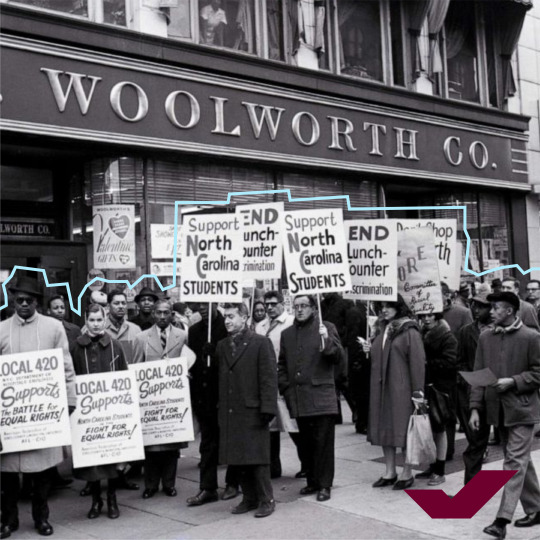
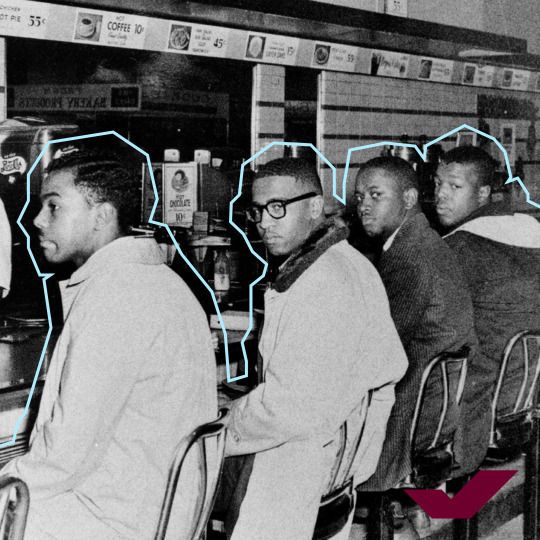
#OTD in 1960: Four Black students from North Carolina A&T sat down at a segregated lunch counter in Greensboro, NC. Despite staff consistently refusing to serve them, they repeated their peaceful protest daily — joined by more and more students. Eventually, 45 students were arrested and charged with trespassing.
The students’ activism helped launch a sit-in movement in over 100 cities, leading to the integration of many stores years before the Civil Rights Act passed in 1964.
64 years after their first day of protest, we honor the bravery and commitment of the #GreensboroFour: Jibreel Khazan (formerly Ezell Blair Jr), Franklin McCain, Joseph McNeil, and David Richmond. Their activism reminds us that young people have the power to inspire radical systematic change 🙌🏿
20 notes
·
View notes
Text

Attorney King Virgil Cheek Jr. (May 26, 1937) is a lifelong educator, lawyer, and author.
He was born in Weldon, North Carolina to Lee Ella Williams Cheek and King V. Cheek Sr. The family moved to Greensboro, where he graduated from James B. Dudley High School.
He attended Bates College, majoring in economics, and received a BA. He went to the University of Chicago, receiving his MA and his JD from the University of Chicago Law School. He passed the Illinois State Bar and the North Carolina State Bar. He became active in the civil rights movement and participated in the March on Washington.
He served as professor, dean, and vice president before being appointed as president of Shaw at the age of thirty-two. He followed his older brother, James Edward Cheek, who had served as president of Shaw University. He became the eighth president of Morgan State University. He received an honorary Doctor of Laws degree from Delaware State College.
He married Annette Walker (1968) and the couple had four children. He is a member of Sigma Pi Phi Fraternity.
He became a professor of social sciences and dean of graduate studies at the New York Institute of Technology. He served as vice president and president of the Union for Experimenting Colleges and Universities, and he co-founded the Center for Leadership and Career Development in DC. He resumed his position as dean of graduate studies at the New York Institute of Technology. He was chancellor of the New York College of Health Professionals. He has written several articles, pamphlets, and books, including I See A New America: It Ain’t Like The One I Used To Know and The Quadrangle.
He served as the economic development consultant to the chief minister of Turks and Caicos Islands, director of the Senior Executive Development Program, Government of Bermuda, member of the board of directors of the Baltimore Museum of Art and the Baltimore Urban League, and member of the board of the North Carolina Association of Colleges and the Association of Eastern North Carolina Colleges. #africanhistory365 #africanexcellence #sigmaphiphi
7 notes
·
View notes
Text
Black History Month -- Clara Luper
There are so many stories of people who were heroes in their own way throughout the civil rights movement and beyond that I could write a story a day for the entire year and not run out. Today’s efforts by some to whitewash history, to remove some of the most significant names from the history books is appalling. I cannot do much, but throughout February, as often as I can I plan to highlight…

View On WordPress
#Civil Rights movement#Clara Luper#Greensboro Four#Jon S. Randall Peace Page#NAACP#segregation#sit-ins
0 notes
Text
MOGAI BHM- Day 3!
happy BHM! today i’m going to be talking about the greensboro four and how they inspired the sit in movement!
The Greensboro Four-
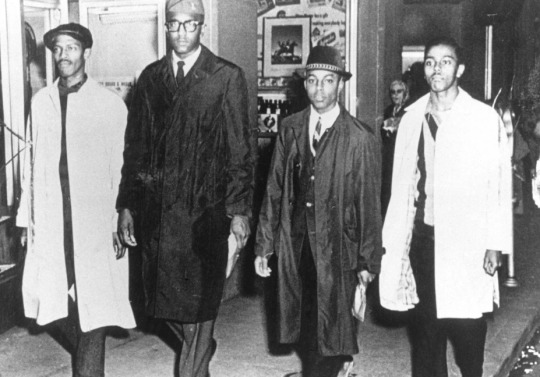
[Image ID: A black-and-white photo of the “Greensboro Four”- four Black male college students. From left to right, they are David Richmond, Franklin McCain, Jibreel Khazan and Joseph McNeil. Two are wearing their college gowns, the other two are wearing long white trench coats. They are walking side by side in a building. End ID.]
The “Greensboro Four”, as they have come to be called, is a group of four Black students who, at the time, attended the Agricultural and Technical College of North Carolina, sparked one of the most well-known and effective movements of the Civil Rights Movement. Their names are Franklin McCain, Jibreel Khazan, Joseph McNeil, and David Richmond- four Black friends who decided to challenge the segregation laws that still subjected Black Americans to the ‘separate but equal’ fallacy in public places.
On February 1, 1960, the four men staged a sit-in at the lunch counter of the popular store Woolworth’s- which didn’t allow Black people to sit there. Although they feared for their safety, they nonetheless went to Woolworth’s and sat at the lunch counter. After being repeatedly asked to leave, they refused, placed their lunch orders, and though the police were called on them, they remained in their places until the store closed, when they left.
Soon after, they got in contact with other Black friends from their university and nearby universities and asked them to join them in future sit ins. The Greensboro Four were soon joined by a growing mass of Black students who sat with them at Woolworth’s lunch counter. At this point, they were faced with threats and harassment, but nobody was physically harmed. Thus, the sit in movement was born.
The Sit-In Movement-
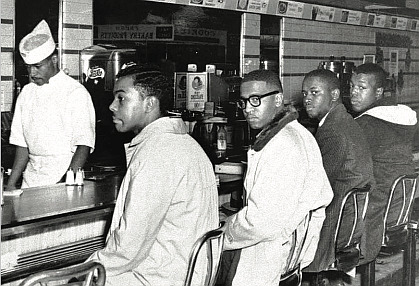
[Image ID: A black-and-white photograph of four Black men sitting at the counter of a lunch place. End ID.]
For months before the first Greensboro sit-in, students across North Carolina had been secretly meeting in houses, Church basements, and YMCA chapters to do underground work- they established phone networks, studied nonviolence and nonviolent protest tactics, and connected with each other to form underground networks of student activists. This dedication paid off after the first Greenboro sit-ins.
Black students spread the word about sit ins all across the South- college towns all across the US began to see a rise in Black students, occasionally accompanied by supportive white students, staging sit ins at segregated stores and restaurants. In the time directly following the Greensboro sit-ins, many stores were opened and closed and then opened again and de-segregated. This was all aided by the student-formed organization the Student Executive Committee for Justice along with Greensboro’s NAACP chapter. By the end of the month, over 30 towns across the US had been home to sit-ins staged by students.
These sit-ins were not spur-of-the-moment. They took months of planning, and each was only acquired through the dedication and work of every single student who participated. In Charlotte, NC, 200 students occupied all the downtown lunch bars. In Rock Hill, it was 300 students. They refused to back down and 4 months later, the Charlotte students saw success with all the downtown bars being desegregated.
Not even two weeks had passed since the first Greensboro sit in when, under the guise of the Nashville Christian Leadership conference, a partner organization under the Southern Christian Leadership Conference, students formed a wildly successful organization to coordinate sit-in efforts and encourage boycotts as well as other nonviolent methods of protest to oppose segregation.
On April 19, 1961, Alexander Looby, a Black lawyer who had been providing legal support to the students who participated in sit-ins, was targeted, and his house was destroyed by a bomber. In response to this, thousands of demonstrators marched to the steps of Nashville’s City Hall, where rising student activist Diane Nash directly confronted Nashville’s mayor, Ben West, forcing him to admit that segregation is wrong and that the lunch counters should be desegregated. After this, Nashville became the first Southern city to start the process of desegregating all of its public facilities.
Despite being arrested, beaten, and threatened, the students did not quit. They were unfairly arrested, beaten, threatened with unfair jail terms and fines, and through all of it, they did not give up. Sit ins raged across the South for years to come. The Freedom Movement grew rapidly out of the Sit-In Movement, and in 1964, the sit-in movement was a major inspiration for the passing of the Civil Rights Act of 1964, which officially illegalized segregation in all public facilities.
Sources-
https://files.nc.gov/dncr-moh/The%20Greensboro%20Four.pdf
https://www.crmvet.org/info/sitins.pdf
https://www.loc.gov/exhibits/odyssey/educate/lunch.html
51 notes
·
View notes
Text


Donald Trump took the stage in Greensboro, N.C. last Saturday calling for rounding up millions of Latinos across America and putting them in mass detention camps as part of “the largest domestic deportation operation in American history.” Unfortunately, this kind of rhetoric has become so common among the MAGA Republican playlist that it’s tempting to see it as a joke. But that wasn’t just somebody’s racist grandfather running off at the mouth or a standup comedian with bad taste playing to the crowd. My parents and grandparents would have called it a dog whistle, but my generation should know it’s a bullhorn. But whatever you call it, it was calculated, drafted, tested and approved as part of the far-right Project 2025 plan to turn back the clock on civil rights, women’s rights, workers’ rights and democracy itself. It was the white Christian nationalist agenda on full public display in all its un-American glory and we can’t afford to take it lightly.
Now, if you haven’t heard about Project 2025, don’t feel bad. Most people haven’t. Founded in 2022 by the ultra-conservative Heritage Foundation, it’s an organization led by Trump insiders preparing for one nation under Trump if the twice impeached and four times indicted former president wins the November election and to call them dangerous is an understatement.
What do you think about overhauling federal law enforcement so that the Department of Justice and the FBI, designed to be independent and insulated from political influence, were controlled directly by a newly elected and emboldened President Trump so he could protect his minions from investigation, arrest and prosecution no matter how many laws they broke? Project 2025 loves the idea.
Want to bypass the Senate confirmation process and stop notifying Congress when we sell weapons to foreign governments? Project 2025 does. What about terminating every diversity, equity and inclusion program in the federal government? Project 2025 says right on. What do you think about invoking martial law, using the military as local law enforcement and locking up Trump opponents? Project 2025 calls that progress.
But how do they plan on doing all this? After all, the federal government is more than just one person in the Oval Office. Trump already learned that lesson when federal employees and even some of his own appointees refused to break the law just because he said so.
But Project 2025 has a solution to that roadblock. They call it Schedule F and it’s a plan to fire as many as 50,000 federal employees and replace them with dyed-in-the-wool MAGA fanatics who swear their loyalty not to America or the Constitution but to Donald J. Trump. They’re not even trying to keep it a secret. But why would they?
You see, Project 2025 isn’t confused about who they are. They’re the MAGA Manifesto committed to the unapologetic vision of right-wing nationalism and they don’t care who knows it. Let’s be honest, these guys are attacking President Biden for pushing “racial equity in every area of our national life, including in employment.” Is that supposed to be a bad thing? Are we supposed to think our president should not be fighting for equality and justice?
That’s what Project 2025 says. But that shouldn’t surprise us. After all, they don’t think folks who look like me are real Americans. Neither does Trump.
But they’re not clowns. They’re highly trained, well-funded political operatives dedicated to winning in November and remaking America in their white nationalist image. They’ve spent the past two years putting together a plan to do just that setting the highest stakes imaginable for this election.
(continue reading)
#politics#donald trump#republicans#fair housing act#project 2025#schedule f#white supremacy#christian nationalism#heritage foundation#a second trump administration will be very very bad#maga manifesto
58 notes
·
View notes
Text
Blake Shelton Unveils Dates for Friends & Heroes Tour 2025 with Trace Adkins, Craig Morgan and Deana Carter
"I get spoiled every night seeing these icons come out and do four or five of the biggest hits of their storied careers," said Shelton of the tour
Blake Shelton is taking some of his favorite artists on the road.
On Sept. 5, the country superstar, 48, announced dates for his Friends & Heroes Tour 2025, a 12-date run spanning North American with special guests Craig Morgan, Deana Carter, Trace Adkins and The Voice alum Emily Ann Roberts.
"The Friends & Heroes Tour is one of my favorite tours because as a fan, I can’t think of a cooler concert to see," said Shelton in a statement.
"I get spoiled every night seeing these icons come out and do four or five of the biggest hits of their storied careers," added the "Honey Bee" singer of Morgan, Carter and Adkins. "And then get introduced to new talent like Emily Ann. I can’t wait."
Ann, who competed on Shelton's team during season nine of The Voice, wrote excitedly of the tour on Instagram, "DREAM COME TRUE! I’m going back on the road with @blakeshelton and joining his Friends & Heroes Tour in 2025 y’all!!!! 🤠 Absolutely CANNOT WAIT for this tour… and to be out there with @cmorganmusic, @deanatunes, and @traceadkins?!"
Kicking off Feb. 27 at Rupp Arena in Lexington, Kentucky, the tour makes stops in cities including Boston, Atlanta and Baltimore before wrapping March 22 at Bryce Jordan Center in State College, Pennsylvania.
Tickets for the Friends & Heroes Tour 2025 first become available through two presales, one for fans who sign up through Shelton's website and another for American Express cardmembers, both of which run from Sept. 10 at 10 a.m. local time through Sept. 12 at 10 p.m. local time.
The general on-sale kicks off Sept. 13 at 10 a.m. local time.
For the tour, Shelton will partner with social impact platform Propeller to support St. Jude Children's Research Hospital. Fans can utilize the program to try and win exclusive experiences and prizes, including a trip to one of the shows.
Last month, the "Happy Anywhere" performer announced his first Las Vegas residency, Blake Shelton: Live in Las Vegas, at The
See the full list of dates for Blake Shelton's Friends & Heroes Tour 2025 below.
Feb. 27 - Lexington, KY - Rupp Arena
Feb. 28 - Knoxville, TN - Thompson-Boling Arena at Food City Center
March 1 - Greensboro, NC - Greensboro Coliseum
March 6 - Newark, NJ - Prudential Center
March 7 - Boston, MA - TD Garden
March 8 - Albany, NY - MVP Arena
March 13 - Greenville, SC - Bon Secours Wellness Arena
March 14 - North Charleston, SC - North Charleston Coliseum
March 15 - Atlanta, GA - State Farm Arena
March 20 - Baltimore, MD - CFG Bank Arena
March 21 - Uncasville, CT - Mohegan Sun Arena
March 22 - State College, PA - Bryce Jordan Center
5 notes
·
View notes